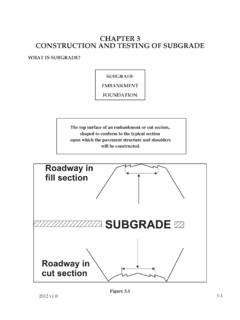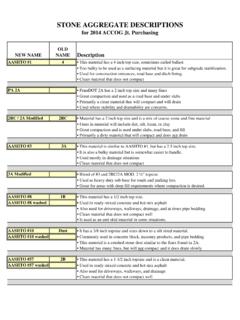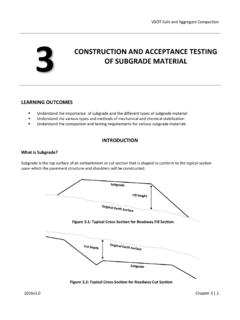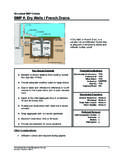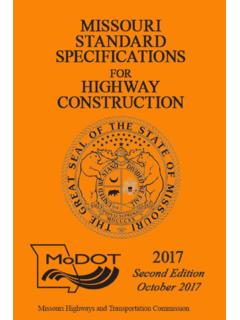Transcription of A Guideline for the Design & Construction of …
1 A Guideline FOR THE Design & Construction OF ASPHALT PARKING LOTS IN OKLAHOMAOKLAHOMA RIDES ON publication is provided by the Members of the Oklahoma Asphalt Pavement Association (OAPA), who are the state s leading asphalt producer/contractor firms and those furnishing equipment and services for the Construction of quality asphalt Members are dedicated to providing the highest quality asphalt paving materials and pavements, and to increasing the knowledge of quality asphalt pavement Design , Construction , maintenance and rehabilitation. OAPA also strongly supports the development and dissemi-nation of research, engineering and educational information that meets Oklahoma s needs in transportation, recreational and environmental Building 3500 N.
2 Lincoln Blvd. Oklahoma City, OK 73105 Phone: (405) 524-7675 Fax: (405) publication is intended to be used as a resource in the the Design and Construction of asphalt parking lots in Oklahoma. OAPA cannot accept any responsibility for the inappropriate use of these documents. Engineering judgment and experience must be used to properly utilize the prin-ciples and guidelines contained in this document, taking into account available equipment, local materials and conditions. All reasonable care has been taken in the preparation of this Guideline ; however, the Oklahoma Asphalt Pavement Association cannot accept any responsibility for the consequences of any inaccuracies which it may NOTICEP ublications produced and published by the Oklahoma Asphalt Pavement Association (OAPA) are copyrighted by the Association and may not be republished or copied (including mechani-cal reproductions) without written consent.
3 To obtain this consent, contact the Association at the address given in this ASPHALT PAVEMENT ASSOCIATIONI ntroduction 2 General Planning 3 Pavement Design Considerations 4 Drainage Provisions Subgrade Preparations Untreated Aggregate Base Construction Prime Coat Hot Mix Asphalt (HMA)/Warm Mix Asphalt (WMA) Base Construction Tack Coat Hot Mix Asphalt (HMA)/Warm Mix Asphalt (WMA\) Surface Course Thickness Design for Parking Lots 7 Asphalt Mat Platform for Building Construction and Site Paving 8 Hot Mix Asphalt Mixture Design 9 Mixture Design The Superpave Gyratory Compactor Aggregate Property Requirements Performance Graded Binder Requirements Warm Mix Asphalt (WMA) Reclaimed Asphalt Pavement (RAP) Reclaimed Asphalt Shingles (RAS)
4 Construction Recommendations 14 Quality Control/Quality Assurance Recommendations 16 Porous Asphalt Parking Lot Pavements Background Design Applications Construction Porous Pavement Summary Summary 17A Guideline for the Design & Construction of Parking Lots in Oklahoma 2 OKLAHOMA ASPHALT PAVEMENT ASSOCIATIONThe parking lot is the first and the last part of a building complex to be viewed by the user. It is the gateway through which all customers, visitors, and employees pass. This first impression is very important to the overall feeling and atmosphere conveyed to the user. Developers and property owners want their facilities to be attractive, well designed, and functional.
5 Though many hours are spent on producing aesthetically pleasing building designs, the same Design consideration for the parking area is often overlooked. Pavements in parking areas that are initially under designed can experience excessive maintenance problems and a shortened service life. In addition, selecting the right materials for the asphalt pavement can assure a pleasing and attractive surface. When properly designed and constructed, parking areas can be an attractive part of the facility that is also safe, and most important, usable to the maximum degree. Parking areas should be designed for low maintenance costs and easy modification for changes in use patterns.
6 This guide provides general information for proper parking area Design and Construction . This includes asphalt mixture and pavement Design and guidance on selecting the right asphalt mixture. Also included is information on Construction best practices and general guidance on facility layout. The asphalt mixes that are used for paving parking lots can vary from fine graded mixes to coarse graded mixes and can be produced as Hot-mix Asphalt (HMA) or as Warm-mix Asphalt (WMA). Each mix type requires that the paving contractor pay special attention to the plant produced mix properties and the methods that are used during placement and compaction. Two important components of this document are the section on controlling the volumetric properties of the mix during Construction and the section on Construction recommendations for HMA paving.
7 Introduction3 OKLAHOMA ASPHALT PAVEMENT ASSOCIATIONIn developing the parking area plan, several important details should be considered. First and foremost in the mind of the developer may be providing the maximum parking capacity in the available space while ensuring convenience and safety. On the other hand, the user will be concerned about sidewalk traffic flow, pedestrian visibility, obstructions and signs. Consideration must also be given to handicap parking. Additionally, areas need to be set aside for bicycle and motorcycle parking. When completed, the parking area should be functional, fit into the overall theme for the building, and aesthetically pleasing in its overall appearance.
8 Criteria have been developed for optimizing parking area space. Among these are the following: Use rectangular areas where possible. Make the long sides of the parking areas parallel. Design so that parking stalls are located along the lot s perimeter. Use traffic lanes that serve two rows of stalls. Special attention should be given to the flow of traffic in and out of the parking lot as well as circulating routes inside the parking lot. Keep entrances far away from busy street intersections and from lines of vehicles stopped at a signal or stop sign. Be sure that the entering vehicles can move into the lot on an internal aisle, thereby avoiding entering congestion caused by involvement with turning vehicles.
9 A pedestrian traffic flow study is important to provide information about both safety and convenience. Parking lot markings are a very important element of a good parking lot. The parking area should be clearly marked to designate parking spaces and to direct traffic flow. As specified in the Manual on Uniform Traffic Control Devices (MUTCD), parking on public streets should be marked out by using white traffic paint, except for dangerous areas, which should be marked in yellow. However, yellow lines are commonly used in off street parking lots. All pavement striping should be four inches in width. New asphalt surfaces can be marked with either traffic paint or cold applied marking tape.
10 For best results with paint application, allow the asphalt to cure for several days. In areas where permeable subgrade material exists, porous asphalt pavement can offer a unique opportunity that reduces storm water runoff. This can eliminate the need for detention basins and, in most cases, will perform better than detention basins in reducing the quality of runoff and pollutants. A properly designed porous asphalt pavement under the right conditions will provide one solution to storm water runoff problems as well as groundwater table recharge. Because of the unique Design and Construction features of this product, information on porous asphalt pavement is presented toward the end of this document.
